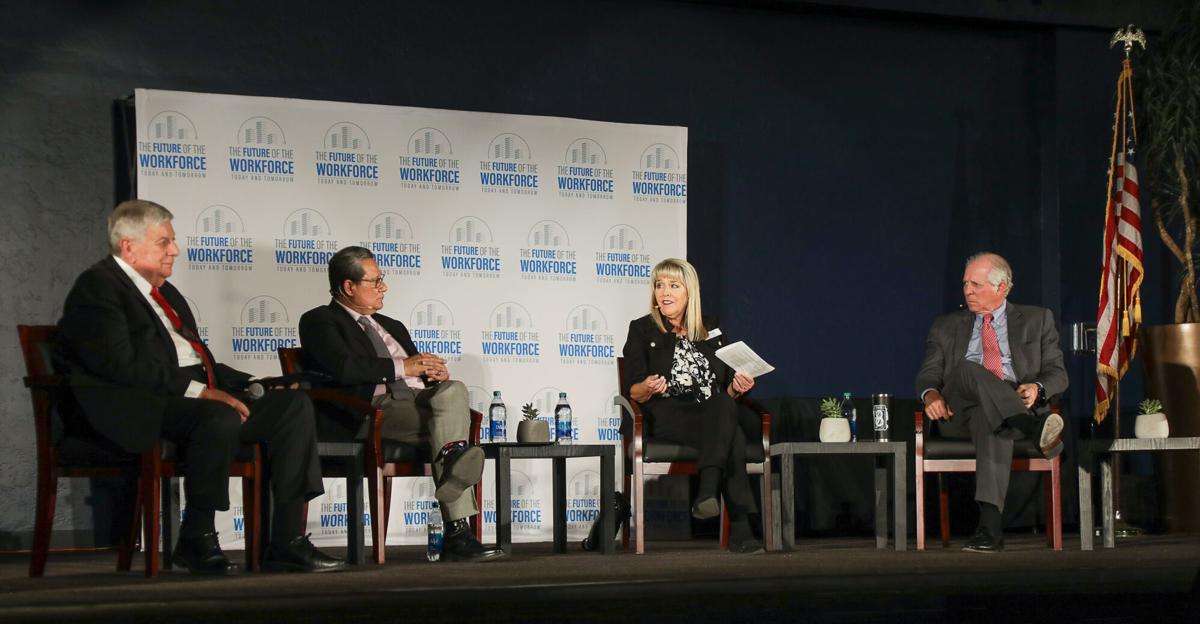Though much of Tucson’s economy has recovered from the shock of the pandemic, the city is lagging the state and the nation in replacing the jobs lost due to COVID-19 shutdowns in 2020.
Turning that around is going to take a major, long-term effort, as many working-age adults in Tucson have yet to return to the labor market, University of Arizona economists said Thursday at a workforce conference whose sponsors include the Making Action Possible Dashboard, the University of Arizona, the Southern Arizona Leadership Council and the Arizona Daily Star.
And a new report issued by the Southern Arizona Leadership Council and the Arizona Board of Regents as part of the “Future of the Workforce” event suggests that boosting the number of college graduates in the state would help solve the labor problem while adding billions of dollars in economic benefits.
Through last month, Tucson had replaced only 83.1% of the 45,500 jobs lost between February and April 2020, lagging the replacement rate for the nation, the state, and all metropolitan areas in Arizona except Sierra Vista, according the Making Action Possible Dashboard, a project of the Economic and Business Research center at the UA Eller College of management.
In contrast, the national pandemic job replacement rate was more than 90%, and Arizona has fully recovered its lost jobs and added 10% more, while Phoenix has added an additional 15%.
Job-replacement rates vary by region and within regions, UA senior economist Jennifer Pullen said at the workforce conference Thursday.
Pullen noted that in Tucson, jobs in the services and leisure and hospitality sectors remain below pre-pandemic levels, but jobs in the trade, transportation and utilities sector have increased driven by warehousing and retail trade.
Dropping out
The bigger issue is finding people to fill thousands of new jobs, as many people are unable or unwilling to return to the workforce in a phenomenon known as the “Great Resignation.”
The unemployment rate across Arizona and the nation is at historic lows, with Tucson’s seasonally adjusted jobless rate of 2.9% in March at a 24-year low, said Pullen, director of the MAP Dashboard.
Yet in January, Arizona had 241,000 job openings, and nationally, for every 10 job openings there were only six unemployed individuals, she noted.
And after recovering since 2020, Arizona’s labor participation rate has worsened from 61.3% in June 2021 to 60.7% in March 2022, in contrast to continued improvement nationally.
Pullen said the decline in labor participation is due to a combination factors, including retirements and people who have quit their jobs or have not returned to their jobs because they need to care for family members, or are taking time off to consider new career options.
In January alone, 104,000 people in Arizona quit their job, while job openings jumped to 241,000 and hiring remained brisk.
Longer term, Pullen said, labor-market participation rates are strongly linked to the educational level of the population, with college graduates much more likely to be in the labor force.
But Tucson’s college-education rate of 32.3% with at least a bachelor’s degree in 2020 trailed the nation and most of its peer Western metro areas, including Phoenix.
Nationally in 2021, 73% of people with at least a bachelor’s degree were in the labor force, compared with about 45% of people without a high-school diploma, Pullen noted.
Not enough grads
The report released Thursday by the SALC shows that Arizona is underproducing bachelor’s degrees, and the state needs to turn out more college grads to keep up with demand.
Between 2020-2030, it is estimated Arizona will have about 68,000 annual job openings that require at least a bachelor’s degree, but at the current rate that will fall short by 26,300 bachelor’s degrees annually, “leaving Arizona unprepared for a competitive workforce,” according to a study by Rounds Consulting Group.
In a message aimed at policymakers, the report says Arizona would reap economic benefits of nearly $5 billion in additional state and local tax revenues over 10 years simply by reaching the U.S. average for educational attainment.
Board of Regents member Ron Shoopman said Arizona has enjoyed a strong recovery and growth recently, but the lack of an educated workforce could hold back that progress.
“It’s a real problem, but it’s also a real opportunity, because the state is still growing,” Shoopman said. “We have great kids who are eager to learn and a great workforce that’s eager to prepare themselves for better jobs. We’ve got to figure out how to do this.”
During a panel discussion, executives of several major local employers say they continue to face challenges in getting qualified workers amid the ongoing labor shortage.
“It’s so critical for our employees that their children have a wonderful education,” said Jill German, president of Roche Tissue Diagnostics in Oro Valley. “We have to be willing to put our money behind education in the state.”





